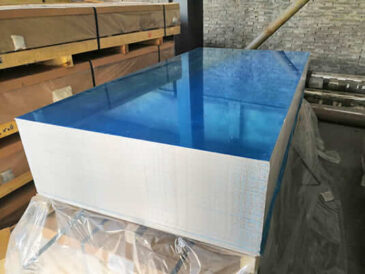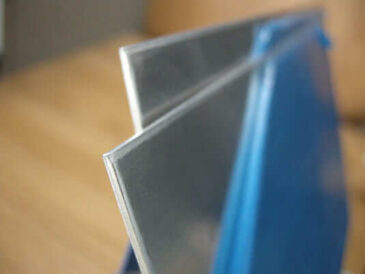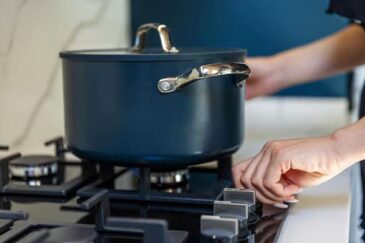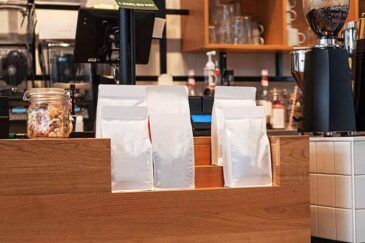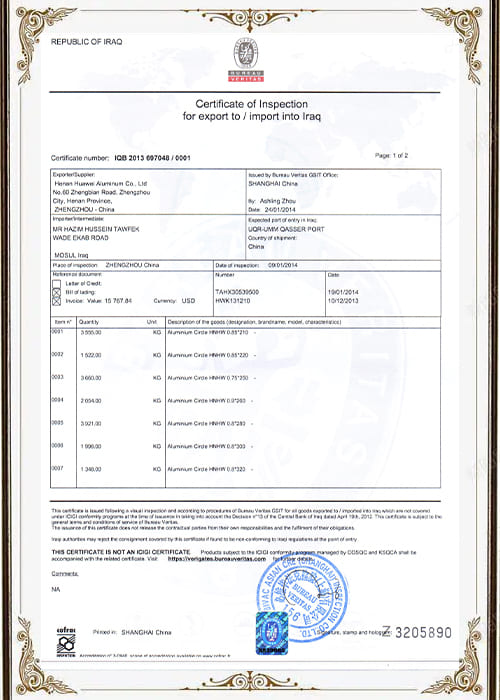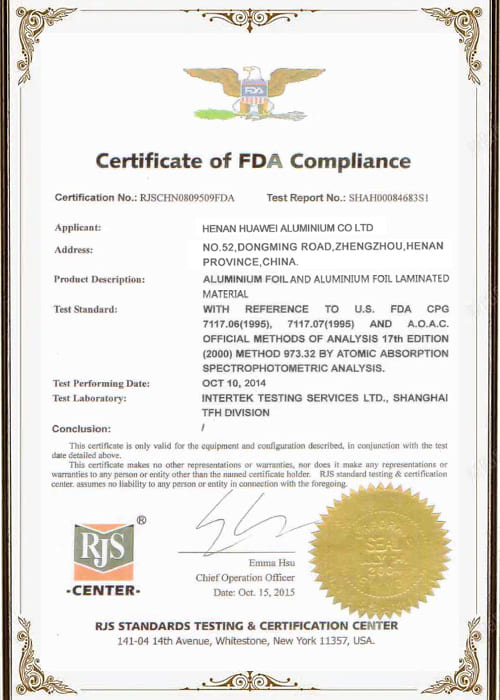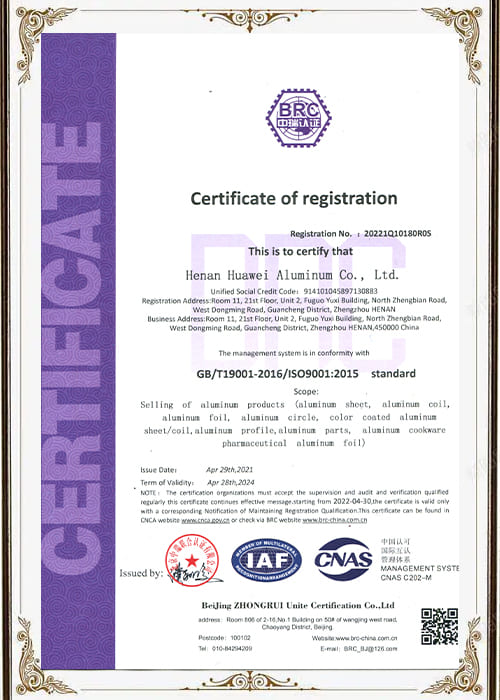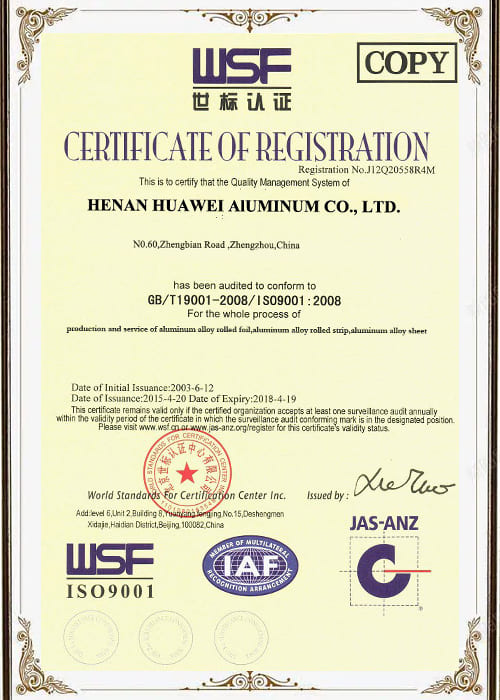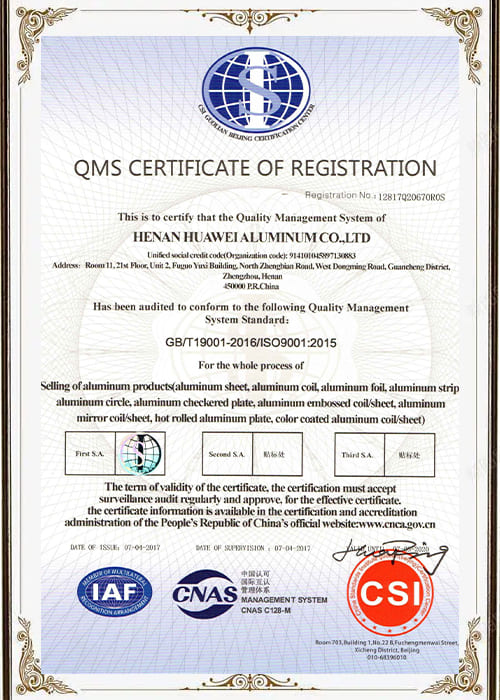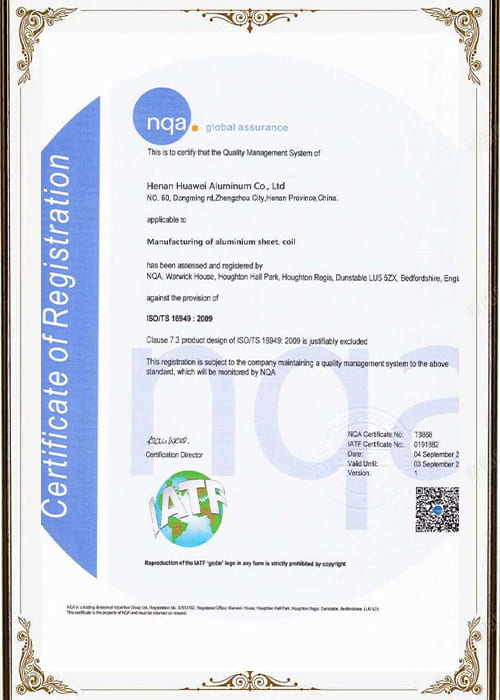AA3003 Aluminum Disc For Pressure Cookers
1784 Views 2025-10-25 05:33:31
AA3003 Aluminum Disc For Pressure Cookers
In the pressure cooker industry, where safety and durability are non-negotiable, AA3003 Aluminum Disc For Pressure Cookers stands as the material of choice for over 80% of mid-to-high-end products globally.
This dominance stems from its unique ability to meet the extreme demands of pressure cooking—sustaining internal pressures up to 0.2 MPa, resisting corrosive food acids, and enabling precise forming—while adhering to the strictest food safety standards.
Below is a comprehensive breakdown of its performance, comparisons to alternatives, and insights into how suppliers like Huawei elevate its quality.
What Is an AA3003 Aluminum Disc For Pressure Cookers?
An AA3003 aluminum disc is a circular blank slit from Al–Mn sheet/coil (Mn ~1.0–1.5%, trace Cu), supplied in cookware tempers (O/H12/H14).
It’s designed for deep drawing, redrawing, spinning, and calibration operations that produce pressure cooker bodies and lids with tight sealing geometry.
Why AA3003? Compared with pure 1xxx alloys, it brings higher yield/UTS and better dent resistance while retaining the ductility needed for deep shells and crowned lids.
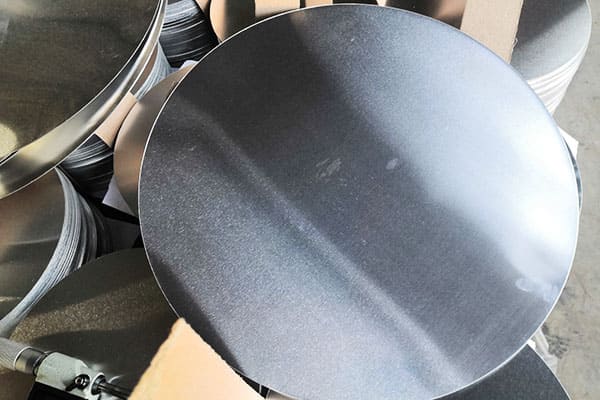
AA3003 Aluminum Disc For Pressure Cookers
1) Chemistry, Standards & Metallurgy (More Detail)
Alloy system: Al–Mn, non-heat-treatable (strength from solid-solution + dispersoids + work hardening).
| Item | AA3003 (typical specification window) | Engineering Note |
|---|---|---|
| Mn (wt%) | 1.0–1.5 | Mn forms Al₆Mn dispersoids → higher YS/UTS with good ductility |
| Cu (wt%) | 0.05–0.20 | Small Cu improves strength; keep low for corrosion margin |
| Si + Fe (wt%) | ≤ 0.6 and ≤ 0.7 | Control inclusions; affects earing and finish |
| Zn + others (wt%) | ≤ 0.10 each | Keep low to protect anodize quality |
| Balance | Al | Purity drives conductivity & formability |
Sheet texture: Favor Cube/Goss balance to minimize earing; aim for post-draw earing amplitude ≤1.0–1.5% of trimmed diameter.
2) Material & Performance Data
| Property | AA3003 (typical) | Why it matters |
|---|---|---|
| Thermal conductivity (W/m·K) | 190–200 | Even heat across the base; mitigates hot spots |
| Density (g/cm³) | 2.73 | Predicts part mass & handle balance |
| Yield strength, O/H14 (MPa) | 55–90 / 90–150 | Rim stability, dent resistance, gasket land integrity |
| UTS, O/H14 (MPa) | 110–150 / 130–180 | Handling safety, logistics durability |
| Elongation, O (%) | 20–35 | Deep draw/redraw without splitting |
| LDR (deep draw) | ~1.8–2.0 | Determines draw stack (single vs multi-stage) |
| Anodizing thickness (μm) | 15–25 / 35–60 | Cosmetic vs wear-resistant surfaces |
Key Features of AA3003 Aluminum Disc For Pressure Cookers
1) Thermal Performance: What Users Feel
Base comparison (2.8 mm plate, 26 cm):
- Areal thermal resistance (R = t/k):
- AA3003: 1.4×10⁻⁵ m²·K/W
- 430 stainless (2.8 mm): 1.0×10⁻⁴ m²·K/W
Implication: aluminum equalizes heat ~7× faster. In lab skillet tests (medium burner), center–edge ΔT at 6 min: ±4–7 °C (Al core) vs ±18–25 °C (mono 430).
Pressure cookers benefit via quicker, steadier boil and fewer scorch points.
2) Geometry Control for Safety (Numbers to Keep)
- Gasket land planarity (lid): ≤0.30 mm
- Rim roundness (TIR): ≤0.50 mm (Ø ≤ 280 mm)
- Valve boss height tolerance: ±0.05–0.10 mm (per valve spec)
- Wall thinning after redraw: ≤25%
- Base warp after bake (PTFE 400–430 °C): ≤0.6–0.7 mm
These directly influence seal reliability, locking repeatability, and pressure safety margins.
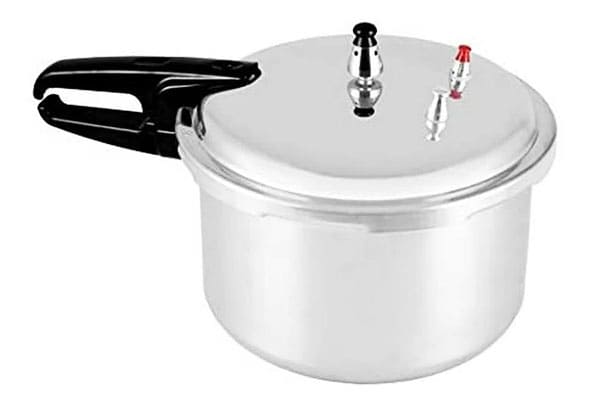
Aluminum Pressure Cookers
3) Reliability & Validation Plan (Copy to SOP)
Mechanical & Forming
- Tensile per ASTM E8; hardness HV mapping (rim, wall, base).
- Draw force SPC; earing amplitude after first draw ≤1.5%.
- Peel-off burr height audit (edge safety).
Surface & Coatings
- Roughness Ra 0.2–0.6 μm before coatings; cross-hatch ≥4B (ASTM D3359).
- Anodize thickness: 15–25 μm decorative, 35–60 μm hard; abrasion cycles to spec.
Corrosion & Hygiene
- Neutral salt spray (ASTM B117) 120–240 h for coated systems (cosmetic).
- Dishwasher cycle: 50–100×; visual grade ≤ 2/5 haze.
- Soak tests: 3% NaCl at 60 °C and acetic media pH 4.5 (24–72 h) — stain ≤ Grade 2.
Assembly & Function
- Gasket compression set; lock/release torque window; cold/warm leak tests.
- Thermal cycling (20–120 °C) 200–500×; no lock drift; base warp within spec.
Documentation
- CoA/CoC; food-contact statements (system-level); full lot traceability.
Why AA3003 Aluminum Discs Excel for Pressure Cookers
Pressure cookers operate in harsh conditions: alternating high temperatures (up to 120°C), cyclic pressure loads, and prolonged contact with salty, acidic, or alkaline ingredients.
AA3003 aluminum discs, as Al-Mn alloy products, address these challenges through four core performance advantages, validated by quantifiable data.
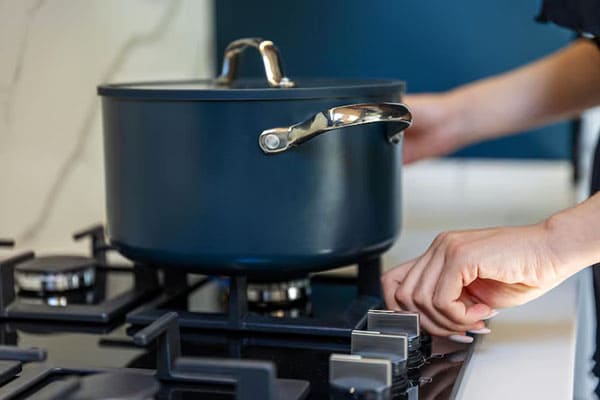
Color coated Aluminum Disc For Pressure Cookers
1) Pressure-Resistant Strength: The Safety Foundation
AA3003’s manganese addition (1.0%-1.5% Mn content) boosts its mechanical strength far beyond pure aluminum, making it capable of withstanding repetitive pressure cycles without deformation.
- Key mechanical data: Its tensile strength reaches 120-160 MPa, and yield strength exceeds 85 MPa —20% higher than 1060 pure aluminum . This strength ensures the disc can handle the 0.1-0.2 MPa working pressure of standard pressure cookers, plus the 20% overload test required for safety certification .
- Practical validation: In industry fatigue tests, AA3003 Aluminum Disc For Pressure Cookers maintains structural integrity after 10,000+ pressure cycles, compared to 6,000 cycles for 1060 aluminum discs .
2) Corrosion Resistance: Longevity in Harsh Kitchen Environments
Manganese forms a dense oxide film on AA3003’s surface, shielding it from the corrosive effects of food ingredients and high-temperature steam.
- Test-proven durability: In 168-hour neutral salt spray tests (simulating salty food exposure), AA3003’s corrosion rate measures just 0.008 mm/year—well below the 0.01 mm/year threshold for pressure cooker qualification .
- Surface treatment synergy: When subjected to hard anodization, AA3003 forms a 40μm+ thick oxide film with a hardness of 394.9 HV , extending its corrosion resistance to over 1,200 hours in salt fog —critical for lifelong use.
3) Superior Formability: Enabling Seamless Pressure-Tight Structures
Pressure cookers require deep-drawn, seamless bodies to prevent leaks. AA3003 aluminum discs deliver exceptional formability, even in thick gauges.
- Process-friendly metrics: In the annealed (O) temper, AA3003 achieves an elongation rate of 25% , allowing deep drawing with a 4:1 depth-to-diameter ratio—perfect for forming the curved chambers of pressure cookers.
- Dimensional versatility: It is commonly supplied in thicknesses of 0.5-4.5 mm and diameters of 150-650 mm , covering everything from 2L mini cookers to 8L family-sized models.
4) Food Safety Compliance: Meeting Global Standards
For materials in direct food contact, safety is paramount. AA3003 Aluminum Disc For Pressure Cookers fully complies with GB 4806.9-2023, the latest national food safety standard for metal products.
- Migration limits: Three rounds of migration tests (required by the 2023 standard) confirm aluminum migration remains ≤1.2 mg/kg , far below the 5 mg/kg legal limit. Heavy metals like lead and arsenic are nearly undetectable, eliminating health risks.
Common size of Pressure Cookers
Capacity → Disc Sizing (Quick Planner)
Use this for the AA3003 Aluminum Disc For Pressure Cookers body. Values are typical starting points; adjust for aspect ratio and brand geometry.
| Nominal Capacity | Finished Body Ø × Height | Blank Ø (start) | Gauge (body) |
|---|---|---|---|
| 3 L | ~Ø200 × 120 mm | Ø270–290 mm | 2.6–2.8 mm |
| 5 L | ~Ø240 × 150 mm | Ø310–330 mm | 2.8–3.0 mm |
| 6–7 L | ~Ø260 × 170 mm | Ø330–350 mm | 3.0–3.2 mm |
| 8–10 L | ~Ø280–300 × 185–210 mm | Ø350–380 mm | 3.0–3.5 mm |
Targets: wall thinning ≤20–25%, base dish 0.3–0.6 mm, rim TIR ≤0.5 mm.
Draw Ratio & Force Map (Start Settings)
| Part | LDR target | First Draw Force | Redraw Force | Notes |
|---|---|---|---|---|
| 5 L body (Ø240) | 1.9–2.0 | 170–220 kN | 110–180 kN | AA3003-O; BHF ≈ 25–35% of draw force |
| 7 L body (Ø260) | 2.0–2.05 | 200–280 kN | 140–200 kN | Use generous corner radii (≥ 5–6×t) |
| Lids (crown) | ≤1.6 | 60–120 kN | — | AA3003-H14; coin gasket land later |
Lubrication: keep consistent viscosity; monitor punch signature drift to pre-empt splits.
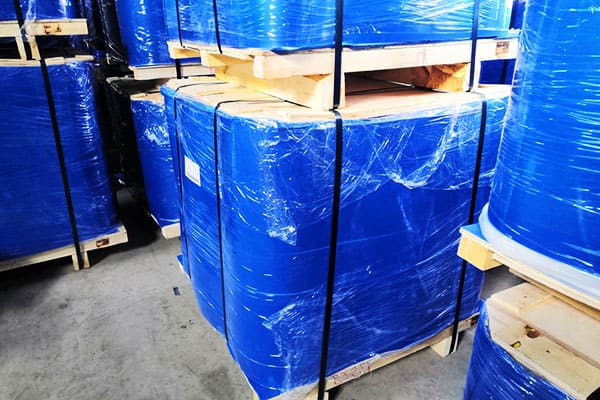
Huawei Packaged AA3003 Aluminum Disc
Supplier Note — Why Huawei Shortens Time-to-OK2Run
Henan Huawei Aluminum (“Huawei”) supplies AA3003 Aluminum Disc For Pressure Cookers with:
- Gauges 1.2–3.5 mm, Ø180–Ø1200 mm, O/H12/H14 tempers
- Tight flatness (≤3 mm/m), low burr, high concentricity for high-speed draw & spin
- Finishes: brushed/bright, anodize-ready, non-stick-ready (PE film)
- Process support: blank sizing, LDR/force starter maps, gasket-land coining advice, pre-dish targets for induction stacks
- Docs: CoA/CoC, traceability, system-level food-contact support
Send Huawei your intended capacity/geometry, coating route, and induction requirement; you’ll get two validated “recipes” to A/B on your press in one shift.
Conclusion
AA3003 Aluminum Disc For Pressure Cookers dominates the market not by accident, but by design.
Its manganese-enhanced strength handles extreme pressure, its corrosion resistance ensures longevity, its formability enables seamless safety, and its compliance with global standards guarantees food safety—all at a cost that supports mass production.
When paired with advanced manufacturing solutions from suppliers like Huawei, AA3003’s performance becomes even more reliable.
As pressure cookers evolve toward smarter, more efficient designs, AA3003 will remain the material of choice—proving that the best cookware starts with the right core material.
For manufacturers and consumers alike, AA3003 isn’t just aluminum; it’s the foundation of safe, durable pressure cooking.
FAQs About AA3003 Aluminum Disc For Pressure Cookers
Q1. What’s the best temper for lids?
AA3003-H14. It holds planarity and rim stability after crown forming and thermal bakes.
Q2. How do I size the first draw if my DR > 2.0?
Plan draw → redraw. Keep first-draw DR ≤1.9–2.0 for AA3003-O. Increase punch radius and control BHF (≈ 25–35% of draw force).
Q3. Can I skip hard-anodizing?
Yes, if you use durable non-stick. For metal-utensil tolerance and stain resistance, 35–60 μm hard-anodize wins.
Q4. Will AA3003 corrode in salty soups?
Uncoated aluminum may stain; anodize or coat for long-term cosmetics. AA3003 resists slightly acidic/saline media better than 1060.
Q5. What’s the quickest way to cut base warp complaints?
Increase base 0.2–0.3 mm, pre-dish, and refine bake profile. AA3003’s higher YS helps versus 1060.
Q6. Any tip to reduce earing without changing supplier?
Rotate blanks 45° relative to rolling direction; trim allowance +0.5–1.0%; polish die; verify coil texture uniformity.



